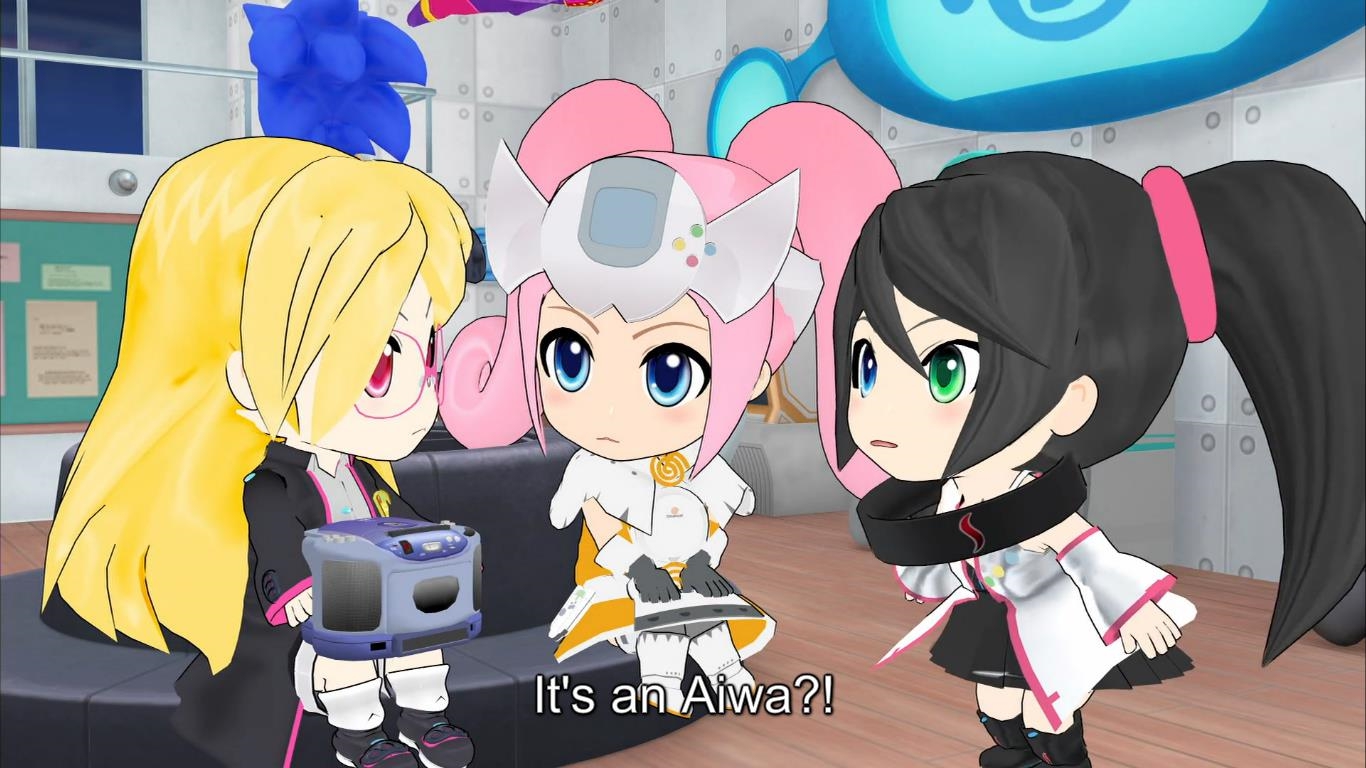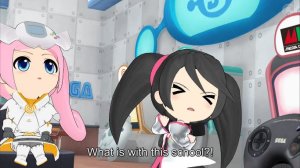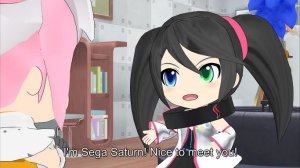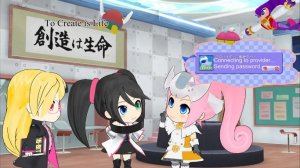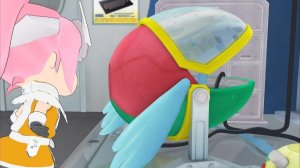I must admit, when I first heard the news that the KEI-designed Sega Hard Girls were getting an anime, I was not terribly enthused. Not because I didn’t like the designs – hell, when I met KEI and was offered a sketch, I requested Saturn instead of the obvious Hatsune Miku – but more because the quality track records of game-themed anime and corporate-made material featuring moe anthropomorphics are pretty abysmal. Strangely, when I heard later that the show was being made in Miku Miku Dance – an inexpensive piece of CG animation software used primarily to create visuals for short music pieces – I became a bit more intrigued. After all, the delightfully absurd show gdgd Fairies had put MMD’s low-budget glory to utterly spectacular use. I said something on Twitter (which I can’t find – thanks, terrible Twitter search engine!) to the effect of “I would be perfectly okay with it if the Sega Hard Girls anime was just gdgd Fairies with old game jokes.”
Little did I know that that’s exactly what Hi-sCoool! SeHa Girls seems to want to be.
If you’re reading this site, I think you probably already have an idea of what the Sega Hard Girls are all about – pieces of Sega game hardware transformed into cute girls that originated as illustrations in some of Sega’s F2P mobile titles and have since taken on lives of their own. The show focuses on three of the girls – MegaDrive, Saturn, and Dreamcast – and their adventures at a strange high school in Ootori, Haneda (which, from the outside, looks very similar to Sega’s main office space). To graduate, they must earn 100 “credit medals” from a mysterious teacher who only seems willing to speak to them as a pixellated Asobin on a monitor. Of course, the setup is really just meaningless, because the show is actually a vehicle to present cute girls saying and doing absurd things and tying it into retrogame references.
I’ve already mentioned gdgd Fairies, and I think comparisons to that show are unavoidable: besides using the same animation style and software (though SeHaGirls definitely looks less clunky), the style of humor is extremely similar. Plenty of other folks have already talked at length about why gdgd Fairies is awesome, and SeHa Girls hits many of the same beats, only with frequent references to old Sega games being the punchline. I’m sure the SeHa Girls director, Souta Sugahara, has something to do with this familiarity: he was heavily involved in both seasons of gdgd, taking the director’s helm in the second season. He’s not the only verified awesome person on staff, either, as he’s co-writing the show with Game Center CX mainstay and blue-blooded Sega nerd Masayuki Kibe.
Things go from zero to absurd pretty quickly: Dreamcast introduces herself to Saturn with a lengthy spiel about appreciating naruto (the food and topping, not the Shonen Jump ninja) and making a failed attempt to connect to the internet. MegaDrive, a quiet and bookish girl, nonchalantly brings out a CD player that the hugest Sega nerds will immediately recognize in order to play the school song in a scene with some utterly hilarious delivery. Then MegaDrive starts grilling Saturn about her taste in men, and it’s even funnier. Yes, it’s nerd/reference humor, but it’s nerd/reference humor that respects its audience and doesn’t make “hey, we’re referencing a thing!” the whole joke.
Things move on to the “classroom,” dubbed the “JoyJoy Room” (another really, really obscure old Sega reference – JoyJoy’s the name of an old 80s newsletter from Sega, among other things). It’s a room filled to the brim with Sega hardware and memorabilia – where they’re introduced to their mysterious teacher. The teacher gives them their first assignment, Virtua Fighter (and here’s where I get nitpicky: did they have to use the notoriously buggy Saturn port to showcase the game?), and after a magical girl transformation, the girls are really, truly in the VF world, no doubt ready to engage in comedy hijinks! Sadly, those are going to have to wait until next week.
The first episode is brief – about 10 minutes – but it already seems to establish what the show wants to do: entertain huge Sega nerds with offbeat humor. Seeing as how I’m basically this show’s exact audience, well, of course I love it already. And if you’re here reading this, I’m already pretty sure that you, too, are the type of individual who will find this a very enjoyable watch. I don’t plan to meticulously analyze ever episode the way big anime blogs do, but if there’s something particularly amusing I’ll probably make a short post highlighting it.
Hi-sCoool! SeHa Girls is currently streaming its English simulcast on Crunchyroll in the USA, and possibly other countries as well. Just one request for the production team: is there any way we can get the arcade board girls in on the mix? Model 2 is waifu material for reals.
